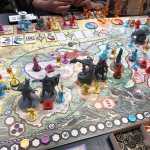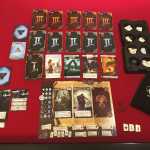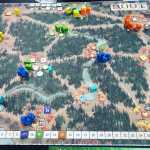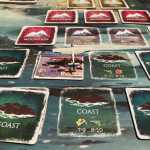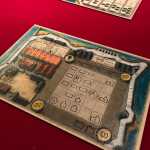Review: Call to Adventure

My hunter stood in the forest's heart, his flame-singed arm holding his sword he had used to guard the poor from the angry, spellbound mob that tried to perform a coup against his rightful rule. His eyes squinted, and set into a firm pose as the Warlock approached. But it was no long fight - the Warlock succumbed quickly to this hero of destiny who had overcome all trials set before him.
Such is the rich story of nearly every game I've played of Call to Adventure, a narrative dice-rolling set builder from Brotherwise Games of Boss Monster fame. The game plays pretty simply; collect runes (dice), perform tests based on "tosses" of those runes, and progress your character's story. I should preface by saying this is not a min/max attribute game, or a test-driven survival challenge - this is a narrative-builder, through and through.
Component Quality

Lets start out with the fabulous insert this game provides - I have not had to waste a single baggie with this game, and cards simply stay in place when taking it with me anywhere. The rune tray is a perfect depth that the runes simply slide out, and the sides fit cards wonderfully. I hope the insert was kept with expansions in mind as I'd hate to have to remove or expand it.
The runes seem a cheaper plastic at first, but after throwing them a few times during the game, you'll appreciate their feathery nature - they bounce easier, and feel more like dice than heavier counterparts would. The cards themselves are a bit thin, but this was probably done to lower costs and is easily solved with sleeves. Given the hidden-information story nature of the game, I would recommend sleeving here.

Where the game really shines, however, is in the card art. The drawings are detailed, complex, and wonderfully rich in color - and there are tons of them. This isn't 3d-rendered art; these are hand-drawn depictions of their scenes that just radiate richness; it's rare to see illustrations of this depth in a game selling for under $50 USD currently. A lot of the card art you could see going against box covers for most games. It's that good.
One big knock against this game is the rulebook. While pretty, and I appreciate the pictures making for easy setup diagrams, the order and flow of it lacks cohesion, and some rules are simply too ambiguous. I found myself googling on a few cards and rule idiosyncrasies, only to find others having the same questions. An errata or expanded FAQ will be needed soon to rectify this, as the rulebook as-is just doesn't match the quality standard of the rest of the game. It's no Sidereal Confluence or Mage Knight, but it's not great either.
Gameplay
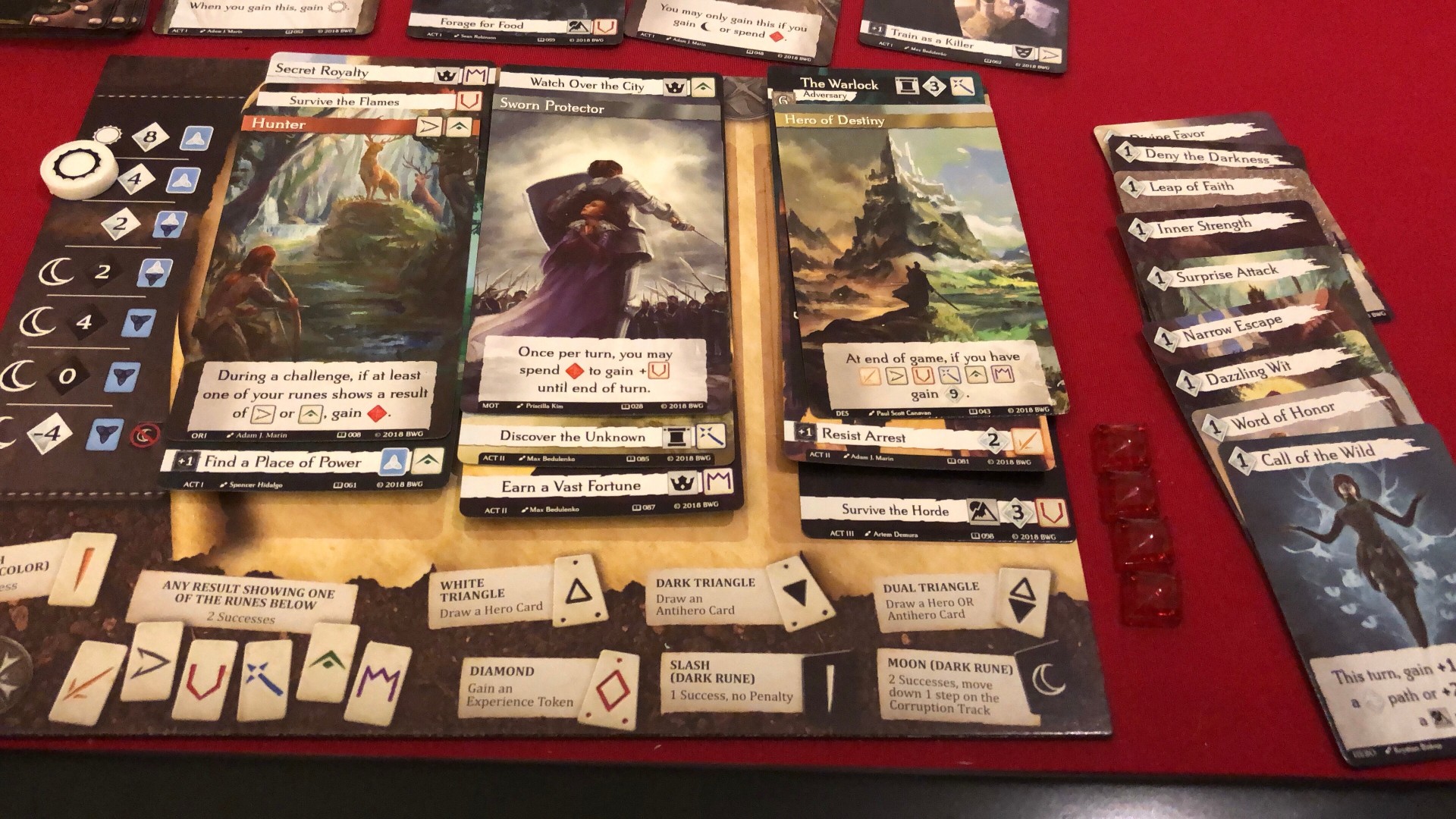
You start out the game with three shaping cards that hold various effects, abilities, or point modifiers. These three cards represent each "act" of your story. Origin states who you are, such as a farmer, hunter, soldier, etc. These will given you your starting runes past the core non-colored 3, as well as some bonus for getting good rolls in those colors.
Motivation that affects how your character evolves and a power you can use - these are highly variant, and usually involve some sort of defining moment that your character endures that forms their outlook. Destiny - a hidden card - rounds out the progression of your hero's arc via scoring bonuses at the end - such as claiming the throne, becoming a crazed villain, or claiming the title of Hero of Destiny.
These three cards ultimately shape and guide your play throughout the game, and give Call to Adventure a lot of the replay value that it enjoys; you'll have vastly different experiences of the game based on these three cards alone. You'll also start with three "experience tokens" that can be used for various things throughout the campaign, such as using dark runes, gaining retries, or other benefits.

Challenges and Traits
Across the board are three separate Acts - you'll progress through each one sequentially. Once you've collected 3 cards from an Act, you'll move to the next, until you complete the 3rd act and the game ends and points are scored. These cards are either traits, challenges, allies, or adversaries. They have a bonus at the top right that you'll get - either points, runes, story symbols, or hero/anti-hero cards - if you complete them. On your turn, you'll pick a card from the Act you're in to attempt.
Traits are simple: if you meet the requirements stated on the card, you get the trait. Challenges, on the other hand, require you to pass a rune test - there will be one or two runes on the challenge that show which types you can use (plus the core set of runes), and you can choose either the top or the bottom path (usually, the bottom is +1 difficulty). Getting a result the same or higher as the difficulty of the challenge nets you the card, which often boosts your rune collection further.
Allies add a bit more complexity - when one is revealed, you can attach it to an existing challenge making that challenge harder, but if you complete it, you get a passive ally that gives boosts, points, or other rewards during the game. Adversaries are more difficult challenges with a single path, that also have passive effects on the game itself while they remain in play.
The Runes

Let's get to the runes - these are effectively 2 sided dice that grant you a point toward your roll result during a challenge. You'll start with a core set of two 1/0 runes and a rune that has 1 or "Draw a card" (hero or anti-hero) on each side. You can also spend experience points to also cast Dark Runes, which are 1/2, but with the two side having a Moon - rolling this Moon will corrupt your character one more level, adding some risk to those dark runes.
Finally, there are six different colors of runes, the first two of each color being 1/2 runes, and the last - only used if you have level 3 attributes in that color - is a 2/2 rune with one side giving you an additional bonus, such as drawing a card or gaining experience tokens. Leveling up these runes are crucial to success in later acts.

Hero Cards
You'll also get Hero or Anti-Hero cards throughout the game. These cards will grant you a point at end of game when you play them, as well as affect some part of the game. Hero cards usually grant you an extra runes or points during a challenge, or help you improve in the corruption track. Anti-hero cards let you manipulate the game in some way, either by retrying challenges with a boost, affecting other players negatively, or other adverse effects. These cards really increase the tension in the game, and I hope Brotherwise Games augments these in future expansions, as they boost the interaction between players and keeps it from being a "solo multiplayer" game.
Corruption Track

On your board is also your Corruption level - get this maxed and you'll add to your score. Similarly, go evil and you'll add more to your score, until you turn pure evil and will lose points. The corruption balance adds some decision making and risk to the game. As you move up, you'll lose the ability to play anti-hero cards; similarly, moving down prevents you from playing hero cards. Move too far down and you won't even be able to use Dark Runes either.
Depending on your strategy, the corruption track can really impact your gameplay - if you're just trying to max your triumph (the good side), you'll likely avoid drawing anti-hero cards and miss out on some of the gameplay. A skilled player can balance the risk of anti-hero cards while keeping their triumph high.

Scoring
The game ends once a player places their third card in the third act, and everyone else gets one final turn. You'll tally the score from cards, experience tokens (+1 each), bonuses, and triumph/tragedy. There are also six different story symbols you can collect during the game; getting multiples of these give you 2 points for 2, 4 points for 3, and 8 points for 4 at end of game. Story symbols can be an easy way to tip the balance of the game in your favor. The game, again, is not really a min-max point game - you'll get far more enjoyment out of living your character than beating your opponents at points.
Solo / Co-Op
 There is also a solo and co-operative mode to the game, as well. You simply pick an Adversary and "compete" against them. Failures give the adversary experience tokens, and if they gain too many, you lose. They also have random effects on the game as you progress as well. Your last turn will always be to "face" the adversary, giving you a goal and target to work toward. You ignore their rune needs at your peril.
There is also a solo and co-operative mode to the game, as well. You simply pick an Adversary and "compete" against them. Failures give the adversary experience tokens, and if they gain too many, you lose. They also have random effects on the game as you progress as well. Your last turn will always be to "face" the adversary, giving you a goal and target to work toward. You ignore their rune needs at your peril.
I played a few run-throughs of this, and found it commonly to be too easy. Adversaries vary wildly in their difficulty, so I had to house-rule the difficulty level a bit to make it competitive. If you're playing your rune sets right it's tough to flat-out lose challenges, which is the adversary's main mode of point-scoring. It was enjoyable, but I'm hoping for more improvements in this area of the game.

Thoughts
I backed Call to Adventure on Kickstarter because it seemed, well, interesting. There are a lot of narrative games out there - just look at the burgeoning RPG market - and games with far more depth than Call to Adventure provides. However, one problem I usually have with story games is their lack of replayability: once you've burned through those games once, there's not really incentive to pick them back up again. The story is old, and only gives comfort in its familiarity as opposed to the high you get on the first read. Essentially those games end up as old books on a dusty shelf, left to remind us of a faded adventure.
Call to Adventure successfully avoids this through its variable card draws and push-your-luck runes. Each of the many times I've played this game so far has been fresh and different - and my play strategy has varied as well. There's a ton of interesting combinations to cards that can make even repeat events feel like new when encountering them, and defensive strategies in higher player counts raises the tension of the game significantly.
The runes mechanic is simple, straightforward, and fun; it injects just enough risk to keep variance high, but not enough that you don't feel in charge of your story. Combined with the set-collection mechanic of types and story symbols and there's a plethora of paths to take when playing each game.
What makes this game really work, though, is the story. I never found myself caring a whole bunch about points - even as an avid Euro fan - and sometimes would just choose a card because it felt like my character. I wanted my farmer to have to save a noble from a fire, simply because it made for a great story, even if the rune award wasn't as good as the other path. I love the arc the Destiny cards inject into the overall gameplay, making your choices throughout the game a challenge to see if you can fulfill their life's path, rather than just "get some points". When playing this, it's really easy to immerse yourself into the story and become your character.
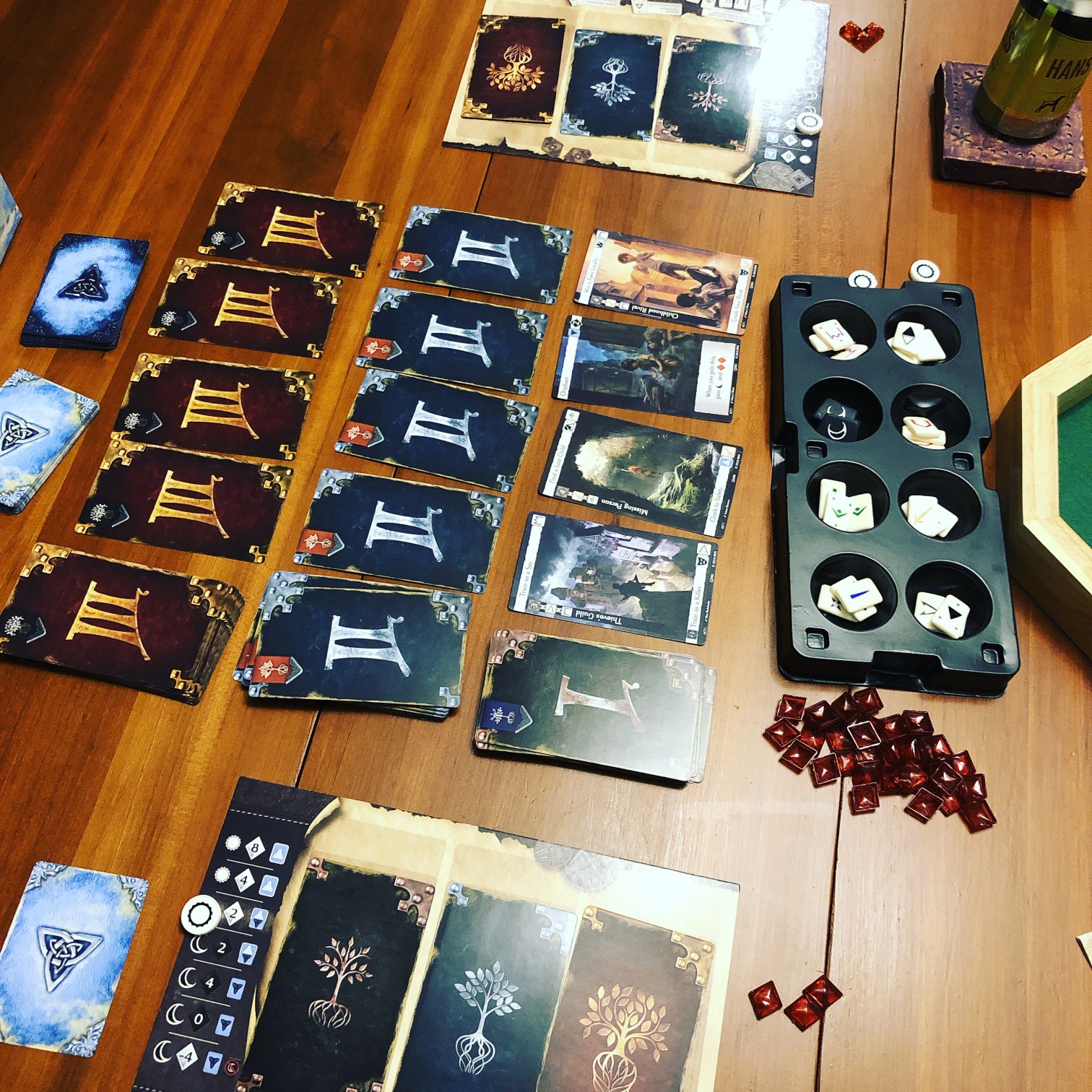 Is Call to Adventure in my top ten? No. Is it a game I will play often? Yes! It simply scratches an itch I have from time to time that not a lot of games fulfill successfully: I want to play a mid-to-light game with a little depth and a lot of fresh, engaging story. I want to get lost in the characters but not have to think. And most importantly, I don't want to have to commit two hours to doing so.
Is Call to Adventure in my top ten? No. Is it a game I will play often? Yes! It simply scratches an itch I have from time to time that not a lot of games fulfill successfully: I want to play a mid-to-light game with a little depth and a lot of fresh, engaging story. I want to get lost in the characters but not have to think. And most importantly, I don't want to have to commit two hours to doing so.
Simply put, if you're looking for a light, fun narrative game with excellent art and design, for a good price, and one that players of any type can enjoy, it's hard to do a lot better than Call to Adventure.
Pros
* Excellent narrative feel, a new story every time
* Fun play mechanics, casting runes is just fun
* Great character development and immersive theme
* Hits a sweet spot in terms of depth and length of play
Cons
* Maybe a bit too light for what it could be
* Lots of rules ambiguities; clarifications/errata really needed
* Solo adversaries are hit or miss
amazing
Board game reviews and news from Austin, Texas. We provide no-nonsense reviews about all kinds of games. With flair.

